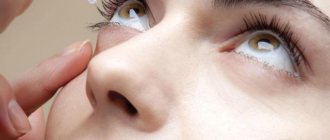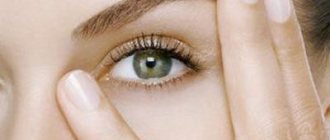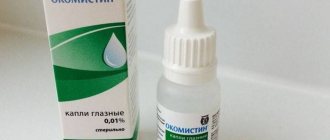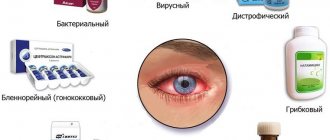Eyes are hypersensitive organs, susceptible to any external influences and internal problems of the body, one of which is vitamin deficiency.
In particular, B vitamins are necessary for the normal functioning of the visual organs , but such elements enter the body with food in very small quantities.
Therefore, you can compensate for the lack of this vitamin with the help of special ophthalmic solutions, one of which is riboflavin in the form of drops.
general information
For reference! Riboflavin eye drops are a vitamin ophthalmic solution containing vitamin B2.
The drug can be used for preventive purposes or as part of maintenance therapy in the treatment of various eye diseases.
The drug has a beneficial effect on the tissues of the main elements of the eye: the retina and lens .
During the use of such drops, normal energy metabolism is restored in these elements, and the tissues are saturated with oxygen .
This drug is also available in the form of injection solutions and tablets.
But in case of vision problems, the use of such dosage forms is inappropriate, since they help normalize the balance of vitamin B2 in the tissues of the body as a whole, and from the point of view of ophthalmology they are practically useless.
Composition and release forms
According to the State Pharmacopoeia, Riboflavin is available in several dosage forms:
Tablets containing the active substance 100 mg. They have a bright yellow or orange color, a bitter taste and a specific smell. The pharmacy chain comes packaged in blisters or dark glass bottles of 50 or 100 pcs.
- Riboflavin in tablet form is also intended for oral administration. Each dragee contains 200 mg of the active ingredient. Packaged in glass bottles of 100 or 50 pcs.
- The solution for injections or Riboflavin mononucleotide is produced by the Russian pharmaceutical company Nizhpharm. Each ampoule contains 1 ml of clear liquid, corresponding to 10 mg of active substance. A cardboard box contains 5 or 10 ampoules. Riboflavin solution is administered intravenously, subcutaneously and intramuscularly.
- Riboflavin is available in the form of a 0.01% solution and is used as eye drops. The drops are packaged in 10 ml dark glass bottles.
The drug can disintegrate very quickly when exposed to sunlight. To avoid this, it is recommended to store it in a dark place. Shelf life: 2 years from the release date indicated on the package.
pharmachologic effect
Vitamin B2, which is part of the riboflavin drops in high concentration, is involved in several processes at once.
Among them are an increase in the level of hemoglobin in the blood, fat, protein and carbohydrate metabolism, regeneration of cellular tissues of the organs of vision and normalization of the mechanisms responsible for the transmission of nerve impulses from the eyes to the brain .
It is worth noting! When it enters the eye tissue, vitamin B2 contained in the drops is converted into riboflavin phosphoric acid, which takes part in the metabolic processes occurring in the tissues.
Subsequently, the breakdown products of this substance are excreted through the kidneys, and if the recommended dosage is observed, such organs do not experience stress or negative effects from the components of riboflavin.
Vitamins included in eye drops
All vitamin drops contain vitamin A. Its main function is to ensure the normal functioning of the retina of the eyes. For myopia, solutions that contain ascorbic acid are considered especially effective. The most beneficial vitamins for the eyes are: vitamin A (carotene), vitamin B1 (thiamine), vitamin B2 (riboflavin), Vitamin C (ascorbic acid), vitamin B9 (folic acid), vitamin B3 (niacin), vitamin B12 (cyanocobalamin) , vitamin B6 (pyridoxine).
The effect of the above vitamins is to relieve fatigue during prolonged visual work. They are actively used to treat corneal dystrophy. These vitamins are multifunctional, so their inclusion is justified in almost all products of similar action.
Indications for use
The main purpose of this drug is prophylactic use for vitamin B2 deficiency .
Keep in mind! In ophthalmology, such a drug is prescribed as an additional prophylactic agent for the following pathologies and disorders:
- decreased visual acuity;
- night blindness;
- corneal ulcers;
- keratitis;
- conjunctivitis;
- glaucoma;
- cataract;
- blepharitis.
The drug can also be used for chronic eye fatigue due to prolonged overstrain as a result of long reading or working at the computer.
Drug interactions
The drug is contraindicated in treatment with drugs that can cause alkaline reactions .
Note! The drops are compatible with most vitamin and therapeutic solutions, so they are prescribed as a supplement when using Oftan Katachrom, Quinax and other similar products.
When used simultaneously with antidepressants, the absorption of riboflavin in the intestine worsens , so in such cases the dosage of vitamin drops can be increased at the discretion of the attending physician.
Instructions for the drug
The drug in tablet form is prescribed to adults for prophylactic purposes in the amount of 0.5-1 tablets 3 times a day. Since the medicine has a very bitter taste, it should not be chewed.
For the treatment of children, it is recommended to use vitamin B2 in the form of tablets in a sweet shell. For children from 1 year to 7 years, no more than 0.5 mg is prescribed. Children over 7 years of age can be given the drug in the same dosage as adults.
If the patient has a severe form of the disease , or it is not possible to take the vitamin orally, it is prescribed in the form of subcutaneous or intramuscular injections. The solution should be administered once a day. Adult patients are administered 1 ml for 10-15 days. For children, the course of treatment does not exceed 4-5 days, 0.5-1 ml.
For preventive purposes, Riboflavin injections can be given every 2-3 days for a month.
Eye drops are prescribed 1 drop in each eye 2 times a day. The duration of the therapeutic course is determined by the doctor individually for each patient, taking into account the severity of his condition and the nature of the disease.
Riboflavin is a mononucleotide in the form of a solution, characterized by good solubility, which makes it possible to administer it intramuscularly and intravenously. The drug is administered intramuscularly, 1 ml 1 time per day. The duration of the therapeutic course is from 10 to 20 days. For children, this medicine is given in a dosage of 0.5−1 ml intramuscularly. During the first 3-5 days, the drug is administered daily, then switched to administration 2-3 times a week.
Side effects and contraindications
As with other vitamin complexes, riboflavin is not characterized by serious side effects (they occur in extremely rare cases).
However, with the development of allergic reactions in case of intolerance to vitamin B2 in high dosages, the following symptoms may
- increased lacrimation;
- redness of the conjunctival membrane;
- photophobia;
- feeling of the presence of sand under your eyelids;
- swelling of the eyelids;
- in some cases, a temporary impairment of visual acuity immediately after instillation (this effect goes away on its own within a few minutes).
It is important to know! A contraindication to the use of riboflavin is an allergic reaction to vitamin B2.
Analogs
Drugs with a similar mechanism of action that can replace riboflavin include:
- Quinax. The drug saturates the lens of the eye with useful microelements. But unlike vitamin complexes, it also has a therapeutic effect, promoting the resorption of opaque protein compounds of a pathological nature formed in the lens. Drops, depending on the existing diseases, can be used from two to five times a day, each time instilling two drops.
- Taufon. A drug rich in vitamins and microelements necessary for the normal functioning of eye tissue. It helps reduce intraocular pressure and is prescribed for the treatment and prevention of retinodystrophy and glaucoma. The product also promotes tissue healing in case of corneal injuries. The drops are instilled 3-4 times a day, two drops each.
- Vita-iodurol. Vitamin ophthalmological complex that promotes restoration and normalization of blood circulation processes in the tissues of the eye. In most cases, such drops are well tolerated by patients; there are no strict restrictions on the duration of treatment. Vita-iodurol is used for the period of time prescribed by the attending physician.
- Emoxipin. A strengthening and regenerating drug that improves the condition of the tissues and vascular system of the organs of vision. Additionally, it has a protective effect by reducing the sensitivity of the retina to sunlight or artificial light. But such drops do not combine well with other ophthalmic drugs, so the use of emoxipine must be agreed with your doctor. It is enough to instill the solution three times a day, two drops into the conjunctival sac of each eye.
Who should take eye vitamins?
1. Anyone who suffers from myopia and farsightedness should take eye vitamins.
2. For people whose age is approaching 40 years or has already “crossed” the anniversary milestone, age-related changes occur in the blood vessels of the entire body, including the eyes, during this period. After all, one of the main directions of action of eye vitamins is strengthening the vascular system.
3. Women with varicose veins, even minor ones, since these ladies constitute the “eye risk” group. The retina of the eyes is extremely susceptible to thrombosis.
4. Patients with cataracts and glaucoma. Vitamins can slow down the development of these diseases in the early stages.
5. People with diabetes, which inevitably affects the organs of vision.
All eye drops
with vitamins are used only on the recommendation of the treating ophthalmologist. Vitamin drops are most often instilled in courses; they are not recommended for constant use.
Quinax and Sancatalin drops most effectively stimulate metabolism and slow down the growth of any cataract: senile, diabetic, traumatic.
Up
Additional recommendations for using the product
Remember! When using riboflavin, the following treatment features must be taken into account:
- There is no precise information about the effect of vitamin B2 in increased quantities on the fetus and breastfed child. Therefore, during pregnancy and lactation, the drug should only under the supervision of a doctor .
- For constipation and in cases where the patient follows a high-calorie diet, it is necessary to increase the standard dosage of the drug .
- For night blindness , using this remedy alone is not enough: for such pathology, riboflavin is prescribed in combination with retinol.
In most cases , with a long course of treatment with this drug, the urine may acquire a pronounced yellow tint.
But this should not be a cause for concern: this color change occurs due to the presence of drug breakdown products in the urine.
Reviews
“ In recent months , after working at the computer for a long time, my have become so tired that at home I can no longer watch movies or even read a book.
Recently I started taking riboflavin drops, and such severe fatigue began to gradually go away .
In addition, the redness of the eyes that occurs against the background of such chronic fatigue has disappeared.”
Lyudmila Bykhovskaya, Omsk.
“ Every spring I have severe vitamin deficiency , which affects not only my general well-being, but also the quality of my vision.
For two years now, have been using riboflavin drops during these periods , as a result of which this problem disappears almost completely .”
Maria Tyshkevich, Votkinsk.











